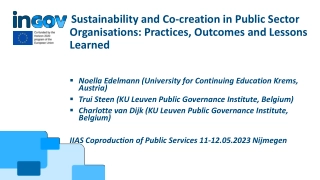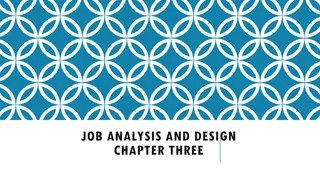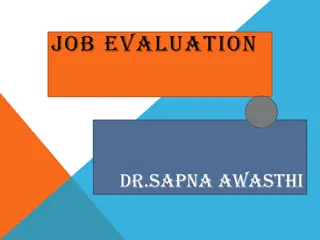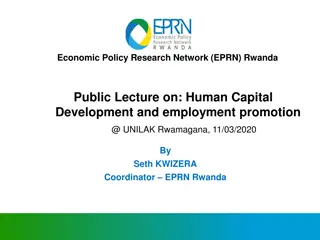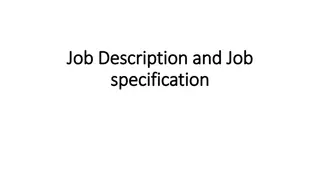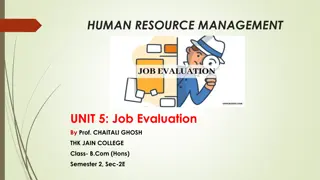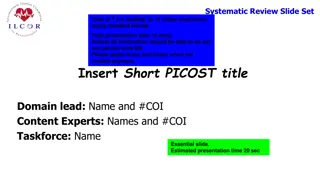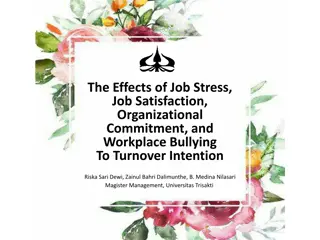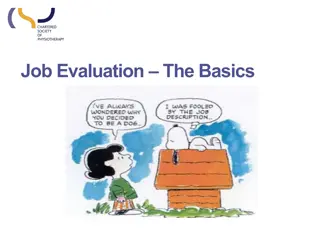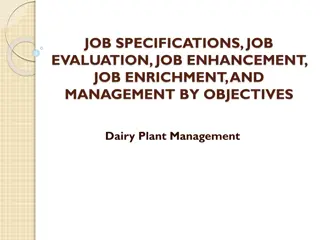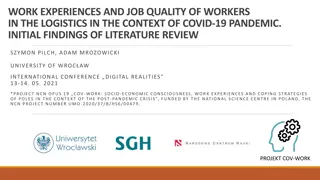Exploring Job Creation Strategies: Insights from a Systematic Review
This presentation delves into the topic of job creation based on a systematic review conducted by Howard White of Campbell Collaboration. The review, led by Michael Grimm and Anna Luisa Paffhausen from the University of Passau, Germany, focuses on interventions for employment generation in micro, small, and medium-sized enterprises in low- and middle-income countries. The presentation also touches on study designs, search strategies, and the comparison between active and passive interventions.
Uploaded on Sep 13, 2024 | 0 Views
Download Presentation

Please find below an Image/Link to download the presentation.
The content on the website is provided AS IS for your information and personal use only. It may not be sold, licensed, or shared on other websites without obtaining consent from the author. Download presentation by click this link. If you encounter any issues during the download, it is possible that the publisher has removed the file from their server.
E N D
Presentation Transcript
Do we know how to create jobs? Findings from a systematic review Howard White CEO, Campbell Collaboration Based on work by by Michael Grimm and Anna Luisa Paffhausen, University of Passau, Germany @campbellreviews @HowardNWhite
This presentation is based on Review by Michael Grimm and Anna Paffhausen Funded by KfW Was registered by Campbell but not completed (will say more about that) Published by IZA and in Labour Economics
PICOS Interventions for employment creation in micro, small and medium sized enterprises in low- and middle- income countries
PICOS Interventions for employment creation in micro, small and medium sized enterprises in low- and middle- income countries Population
PICOS Interventions for employment creation in micro, small and medium sized enterprises in low- and middle- income countries Intervention
PICOS Interventions for employment creation in micro, small and medium sized enterprises in low- and middle- income countries Outcomes
What about C & S Comparison: active (if so, what) or passive, or both. Not usually it title of review but must be explicitly stated in protocol Study designs: this is an effectiveness review so eligible study designs are valid experimental and non-experimental designs which control for selection bias
Search strategy Electronic databases RePEc (Research Papers in Economics) / IDEAS (IDEAS uses the RePEc database); SSRN; EconLit; Labordoc (ILO); 3ie's database of policy briefs, systematic reviews and impact evaluations; Innovations for Poverty Action Publication Database; JPAL Evaluation Database; JPAL Publication Database; ILO Youth Employment Inventory; Research for Development; Web of Science.
Search strategy Websites screened AFD (Agence Francaise de Developpement); African Development Bank; Asian Development Bank; AusAid (Australian Agency for International Development); CIDA (Canadian International Development Agency); DFID (Department for International Development); GDI (German Development Institute); GIZ (Deutsche Gesellschaft f r Internationale Zusammenarbeit); IADB (InterAmerican Development Bank); IDS (Institute for Development Studies); IFC (International Finance Corporation); ILO (International Labor Organization); KfW Development Bank; ODI (Overseas Development Institute (ODI); OECD (Organisation for Economic Co-operation and Development) Development Center; SIDA (Swedish International Development Cooperation Agency); The SME Initiative at Innovations for Poverty Action (IPA); UNDP (United Nations Development Program); USAID; World Bank Group.
Search strategy Hand-searches of key journals Agricultural Economics; American Economic Review; American Economic Journal: Applied Economics; American Journal of Agricultural Economics; Econometrica; Economic Development and Cultural Change; ESR Review (previously Journal of Microfinance); Journal of African Economies; Journal of Development Economics; Journal of Development Effectiveness; Journal of Development Studies; Journal of Labor Economics; Journal of Political Economy; Journal of Small Business Economics; Quarterly Journal of Economics; Review of Economic Studies; World Bank Economic Review; World Development
Search strategy Literature snowballing For included studies, citation tracking was conducted (forward searching). Moreover, their references have been screened for further relevant studies (backward searching). Furthermore, the bibliographies of the World Bank s World Development Report 2013 on jobs and the following completed reviews have been hand-searched for relevant studies: Cho and Honorati (2014); Cirera et al. (2011); Duvendack et al. (2011); Hagen-Zanker et al. (2011); McKenzie and Woodruff (2012); Nataraj et al. (2012); Stewart et al. (2012); Stewart et al. (2010).
Search results and intervention categories 2,275 record identified through database searching Identifi- cation 1,924 records screened after duplicates removed Screening 1,785 records excluded (mostly because not related to our research question) 139 studies assessed for eligibility 84 studies excluded 5 not obtained 15 studies ongoing Eligibility 55 studies included Incl. 27 RCT studies 93 impact estimates 20 additional records identified through other sources Included Intervention types Not adding up to 55 because some studies cover more than one intervention type Entrepreneurship training 20 studies / 16 RCTs Access to finance and insurance 26 studies / 13 RCTs Business development services and targeted subsidies 10 studies / 1 RCT Improvements of business environ- ment: Incentives to formalise 5 studies / 1 RCT 12
Key findings on employment 26 studies, 40 Treatment effects: 13 positive, 2 negative, 25 insignificant No large employment effects, particularly not in micro-enterprise. More business creation than hiring of new workers Interventions mostly do not have job creation as major objective (but rather income stabilisiation, higher family income). Employment effects larger if owner is male. Access to finance and insurance 20 studies, 31 treatment effects: 9 positive, 1 negative, 21 insignificant Successful training does not necessarily lead to employment generation: it can even lead to closing down unsuccessful enterprise. Training should be substantial (about 1 year, once a week) and specific. Tackling finance impediments at the same time seems to make employment effects more likely. Entrepreneur- ship training 10 studies, 7 positive or mixed, 1 negative (minimum wage), 1 insignificant Targeted subsidies for hiring a worker or for innovations/R&D can contribute to employment generation Subsidies and services should be demand (not supply) driven, tailor-made and focussed. Expensive interventions Business develop- ment services and targeted subsidies 5 studies, employment effect after formalisation 4 positive, 1 insignificant Only few (larger) and new firms formalise; for microentrepreneurs often formality has more disadvantages than advantages. Formalisation, where it worked, had only modest employment effects. Better services that firms gain access to with formalisation offer incentives to give up informality and might contribute to job creation as well. Business environ- ment: Incentives to formalise
But relies on vote counting rather than meta-analysis Vote counting give equal weight to all studies and so Ignores size of effect Size of sample on which it is based And fails to exploit additional power available by combining samples
A forest plot (effect measured as odds or risk ratio so no effect = 1) Intervention is harmful Intervention works 1.21 Confidence interval 1 = no effect
Pooling evidence Intervention is harmful Intervention works Use meta-analysis to combine effect sizes 1 = no effect
Pooling evidence Intervention is harmful Intervention works So pooling data allows us to overcome the high risk of Type II error 1 = no effect
Pooling evidence Intervention is harmful Intervention works So pooling data allows us to overcome the high risk of Type II error And vote counting can be very misleading (DON T do it) 1 = no effect
The worlds best known forest plot Corticosteriod for women about to deliver prematurely 30-50% reduction in mortality Vote counting kills babies
In summary Some promise from employment programmes But small effects and heterogeneity Need meta-analysis for cleaer statement about effects and correlates of effects
Thank you Visit www.campbellcollaboration.org Attend geis2018.org


